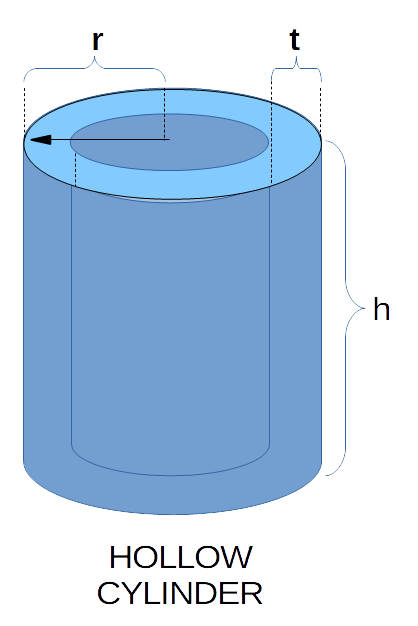Hollow Cylinder Mass
Tags | |
UUID | 424c25e6-0420-11e4-b7aa-bc764e2038f2 |
The Mass or Weight of a Hollow Cylinder calculator computes the mass of a hollow cylinder based on the dimensions and the density. This is for an open ended cylinder with no top or bottom. Open Ended (no top or bottom)
Open Ended (no top or bottom)
INSTRUCTIONS: Choose units and enter the following:
- (h) Height of Cylinder
- (r) Outer radius of Cylinder
- (t) Thickness of Cylinder Wall
- (mD) Density of Cylinder Material (default of 7.85 g/cm3 for steel)
Hollow Cylinder Mass(M): The calculator returns the mass of the hollow cylinder in grams (g). However this can be automatically converted to other mass and weight units via the pull-down menu. The calculator also returns:
- (M) Mass or Weight of hollow cylinder in grams.
- (CV) Casing Volume, which is the volume amount of material in the hollow cylinder in cubic centimeters (cm3)
- (HV) Hollow Volume for the volume within the cylinder (inside the casing) in cubic centimeters (cm3)
| Common Material Densities (mD) | ||
| Material | Density | |
| Steel | 7.85 g/cm3 | |
| Copper | 8.92 g/cm3 | |
| PVC | 1.38 g/cm3 | |
| Aluminum | 2.7 g/cm3 | |
Hollow Cylinder Calculators
- Mass of a Hollow Cylinder
- Volume of a Hollow Cylinder
- Surface Area of a Hollow Cylinder
- Moment of Inertia of Hollow Cylinder
The Math
The formula for the mass of a hollow cylinder is:
`M = pi * h * ( r^2 - (r-t)^2) * mD`
where:
- M = mass of the hollow cylinder.
- h = height
- r = outer radius
- t = thickness
- mD = Mean Density of cylinder material.
The Mass of a Hollow Cylinder calculator computes the volume of the outer cylinder and subtracts the volume of the inner core. It then uses the formula for mass from volume and density:
where:
- V is the volume
- mD is the mean density.
The mean density(mD) of many common substances, elements, liquids and materials can be found by clicking HERE (e.g. the mD of water is 1,000 kg/m3).
Mean Density Table
| Common Mean Densities in Kilograms per Meter Cubed (kg/m3) | ||
|
Fluids
Fuels
Market-Ready Grains |
Metals
|
Earthen
Synthetic
Organic
|
| Mean Density Lookup Function | ||
Mean density is scientifically volume divided by mass. There are various unit for density adopted by cultures and industries. Common units for density included the following:
- kilograms per cubic meter (kg/m3)
- grams per cubic centimeter (g/cm3)
- grams per liter (g/L)
- pounds per cubic feet (lb/ft3)
- ounces per cubic inch (oz/in3)
- pounds per barrel (lb/bbl)
- pounds per bushel (lb/bu)
If you want to identify a material by its density, use the Density Within Range tool.
- Comments
- Attachments
- Stats
No comments |

